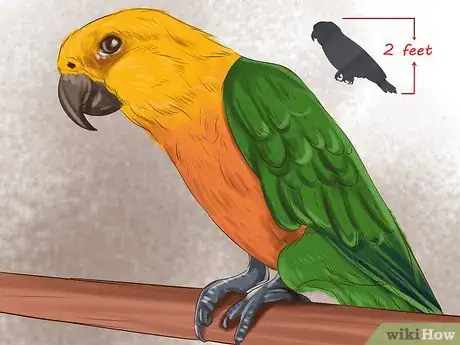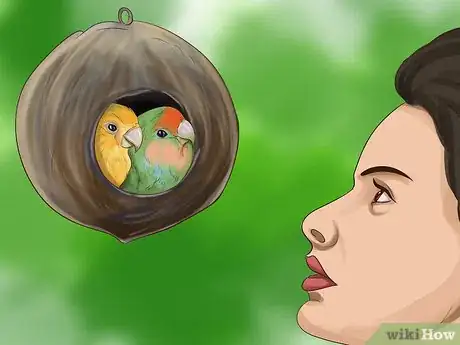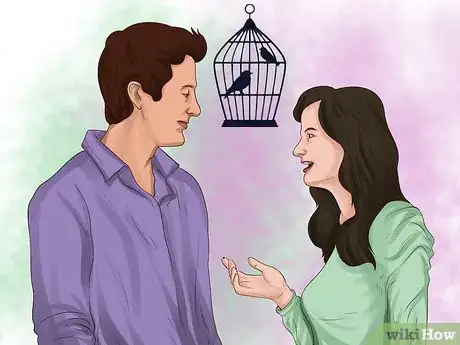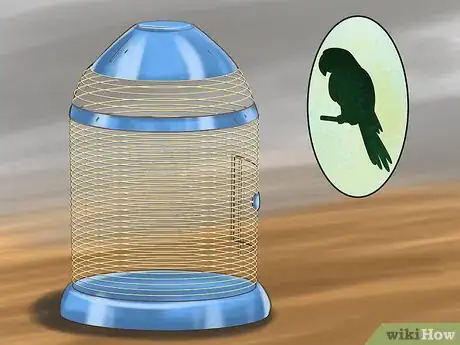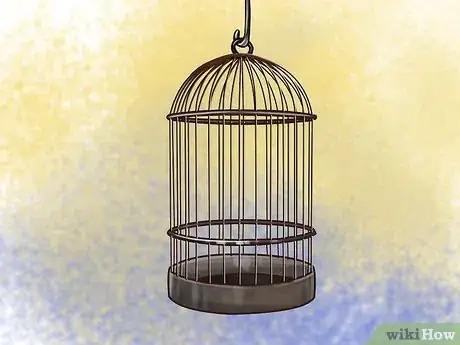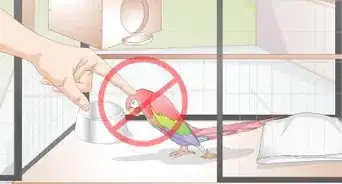This article was co-authored by Pippa Elliott, MRCVS. Dr. Elliott, BVMS, MRCVS is a veterinarian with over 30 years of experience in veterinary surgery and companion animal practice. She graduated from the University of Glasgow in 1987 with a degree in veterinary medicine and surgery. She has worked at the same animal clinic in her hometown for over 20 years.
This article has been viewed 46,156 times.
Parrots are a popular type of bird to own as a pet; they are beautiful and intelligent, and pet owners are often drawn to parrots’ attractive feathering and loud, vocal squawking. However, there are several things to consider when choosing which parrot to buy. Parrots vary in size, volume, and attitude, and some breeds can be challenging and expensive to maintain. With some research, you can find a parrot that’s right for you.
Steps
Researching Types of Parrots
-
1Consider your experience with parrots. Certain breeds are more challenging to own, and better left to experienced bird owners. Parrots such as budgies and cockatiels are best for beginners; Cockatoos, Amazons, and Macaws are better for advanced parrot owners.
- If you’re just interested in parrots but not ready to own one, consider fostering for a rescue group before purchasing a parrot, as they can live for sixty or more years.
-
2Plan for the size of the parrot. You should also consider how comfortable you are with large parrots; some people are intimidated by Conures (which can reach 2 feet), and others can handle any Macaw (which can surpass 3 feet).
- Try going to a bird store or rescue to handle parrots of different species and judge how comfortable you are with various birds.
- If you’re looking for a smaller breed, a parakeet or cockatiel may be more appropriate.
- Larger parrots can also make more noise; if you live in a small apartment, a large Cockatoo is hardly going to make your neighbors—or landlord—happy.
- Additionally, consider how a large bird will affect your life: is your roommate or girlfriend going to be happy with sharing you with a loud, protective parrot?
Advertisement -
3Plan to accommodate the lifespan of a parrot. Although there are exceptions, larger parrots generally live longer than smaller parrots. Smaller parrots are better choices for beginning parrot owners, while larger parrots are usually more demanding and better for experienced parrot owners.
- Amazons may live up to 50 years, while Cockatoos and Macaws can live to be 80. On the other end of the spectrum, the average lifespan of a Budgie is 8 years, and parakeets live from 12-18 years.
-
4Decide if you want a more or less vocal bird. Parrots can wisely vary in their vocal range; some are quite loud, while others squawk less.[1]
- Smaller, quieter birds—such as parakeets or cockatiels—are more suited to living in a smaller apartment.
Matching a Parrot to Your Lifestyle
-
1Decide how much time you have to commit to a parrot. Large parrots are more social birds and only appropriate if you’re prepared to commit a large amount of time to your parrot (at least 60 minutes a day).
- If you’d prefer to just watch your parrot and dedicate a smaller amount of time to caring for it, a better fit would be a pair of budgies or Lovebirds.
- Ask yourself: Are you or another family member home most of the time, or is your family constantly on the go? If you work full time and are seldom home, a parrot isn’t an appropriate pet.
-
2Appraise the size of your budget. Parrots are expensive pets. Large parrots especially are expensive to buy, and more often than not even more expensive to care for. Just like you would with a dog, you have to take your parrot to a vet every year for a “bird wellness check.” Decide on how much you’re prepared to spend on the parrot, and then consider which parrots would fit your budget.
- You’ll also have to spend more on a cage the larger the parrot is, and it can be more expensive to hire a business or person to care for a large parrot while you’re traveling.
-
3Accommodate other pets that you already own. Although parrots make excellent pets on their own, they do not always get along with other pets. Large parrots such as Macaws can be territorial and defensive, and may attack smaller pets.
- Large parrots such as Macaws and Amazons—and even smaller parrots like Conures—are a big time commitment.
- Parrots generally do not socialize well with cats.
- If you bring home a young parrot and another pet (e.g. a dog) at roughly the same time, the two pets will grow up together. This will increase their likelihood of getting along socially, as the two pets will be very comfortable around each other.
- In addition to social factors, time is an issue. Parrots need frequent socialization and maintenance, and are time-intensive pets. If you already own several other pets, a parrot may be too much of a time commitment.
Selecting and Buying Your Parrot
-
1Choose an individual parrot. Like buying any other type of pet, there is no objective ruling on which individual parrot (e.g. one out of fifteen cockatoos) will make the best pet.[2] Rather, see which individual bird interests you the most. When selecting your pet, you should:
- Make sure you understand the adult behavior of the breed you’re looking at. Some cute, quiet juvenile parrots may grow up into loud, abrasive parrots.[3]
- Spend time—about 30 minutes—watching the birds. See which birds seem more social, active, and engaged. Consider choosing one of these, as these birds will make more fun, interesting pets.
- Decide which bird appeals most to you, by looking at its plumage and watching its behavior. Choose a parrot that you find visually appealing and whose personality you will enjoy living with for years.[4]
-
2Ask the pet-store owner about the individual birds. The owner will have spent substantial time with the birds in the store, and should be able to give you advice about which bird(s) will make good pets. It’s especially important to talk to the owner if you are a first-time parrot owner.
- The location of a pet store itself may influence the type of parrot that you purchase. If you live in a large metropolitan area, you can likely find any breed you like—otherwise, you will be limited by local availability.
- Ask the owner if any of the parrots have been showing signs of lethargy or illness. Do not choose one of these birds as a pet.
-
3Prepare for your parrot’s diet. You should feed your parrot once a day, and provide parrot pellets or “parrot mix,” available from your local pet shop.[5] Since parrots are tropical birds, you should also provide a selection of fruits and vegetables each day.
- A poor or inadequate diet is a common cause for illness in parrots. By making sure your parrot receives the nutrition it needs, you’ll keep it in good health and save on future vet bills.[6]
- Parrots can eat nearly all foods that are commonly consumed by humans, including:[7]
- Cooked meat and fish.
- Peanuts and cheese.
- Do not give your bird chocolate or avocado; both are poisonous to them.
-
4Purchase an appropriate cage for your parrot. The cage is a major purchase (in both expense and importance) and should be planned ahead of time. Buy your parrot as spacious of a cage as possible, and remember that a simpler cage will be easier to clean.[8]
- Cover the bottom of the cage with shredded newspaper—this is easily replaceable, cheap, and can be changed frequently.[9]
-
5Hang the cage in your apartment or house. The location of the parrot cage is important. Do not place it near doors, as the bird may escape. Also avoid housing your parrot cage in the kitchen; cooking fumes can be fatal to your parrot.[10]
- Although you will need to take your parrot out of its cage to socialize it, do not leave the bird unattended out of the cage. Parrots have powerful beaks, and can destroy furniture, drapes, etc.[11]
References
- ↑ https://www.petfinder.com/pet-adoption/other-pet-adoption/adopting-a-bird-choosing/
- ↑ http://www.parrotscanada.com/choosing/choosingyourbird.html
- ↑ http://www.parrotscanada.com/choosing/choosingyourbird.html
- ↑ http://www.parrotscanada.com/choosing/choosingyourbird.html
- ↑ http://www.theparrotsocietyuk.org/pet-parrots/a-complete-beginners-guide
- ↑ https://www.petfinder.com/pet-adoption/other-pet-adoption/adopting-a-bird-choosing/
- ↑ http://www.theparrotsocietyuk.org/pet-parrots/a-complete-beginners-guide
- ↑ http://www.theparrotsocietyuk.org/pet-parrots/a-complete-beginners-guide
- ↑ http://www.theparrotsocietyuk.org/pet-parrots/a-complete-beginners-guide
About This Article
To choose a parrot, the best thing to do is go to a bird store or rescue and observe different species to get a feel for their needs and personalities. If this is your first bird, consider something smaller like a budgie or a cockatiel, since they aren’t as noisy as big birds and don’t require as much attention. You should also consider the bird’s lifespan, since some birds, like budgies, live an average of 8 years, whereas others, like cockatoos, can live as long as 80. Don’t be afraid to ask the store owner questions to find out more about the different birds, like how much energy they usually have and if they have shown any signs of lethargy or illness. For more tips from our Veterinary co-author, including how to prepare your home for your new parrot, read on!

